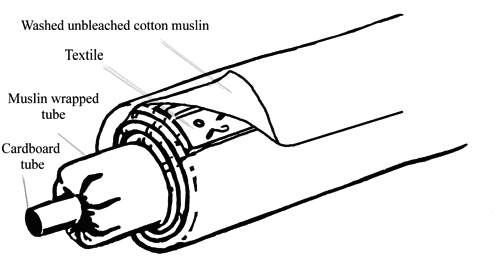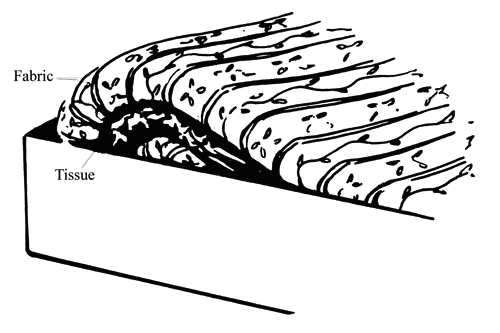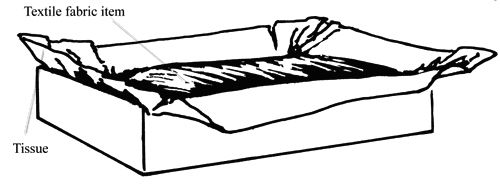G1820
Care of Quilts: Storage and Display
Special precautions must be taken when displaying and storing fragile quilts.
Shirley M. Niemeyer, Professor, Extension Specialist, Environment/Housing/Textiles
Patricia C. Crews, Willa Cather Professor of Textiles, Clothing and Design and Director, International Quilt Study Center & Museum
Antique textiles, including quilts, are very fragile. Excessive handling and washing can hasten deterioration. Light quickly fades colors and weakens natural fibers. Careful control of handling, storage and display conditions can prolong the life of quilts.
The care and precautions you take with your quilts depend in part on whether you want to preserve your quilts for future generations or whether you want to display, enjoy and use the quilts in your home. To preserve a quilt indefinitely requires ideal storage conditions. The ideal conditions include storage of the quilt flat and completely unfolded in total darkness at a constant temperature of 50°F to 60°F and a relative humidity of about 50 percent. Most private quilt collectors, as well as some museums, do not have ideal storage conditions; however, there are many ways to prolong the life of your quilts, even those you use or display.
Storage
Store quilts flat, if possible. If the quilts must be folded, fold them as few times as possible. Periodically, refold them to redistribute the strain that develops along fold lines. Quilts that remain folded for long periods may develop permanent creases and eventually the fibers are likely to break under the strain along these creases. Avoid stacking heavy quilts or other items on top to prevent creasing the quilts and crushing the batting.
Quilts may be rolled onto large cardboard tubes (Figure 1). Use a tube that is longer than the width of the quilt and at least 4 inches in diameter to minimize strain. Pad the tube by covering it with a layer of cotton batting or resin-free polyester batting. Then cover the tube with acid-free tissue or washed cotton muslin. Roll the quilt loosely around the tube, being careful to avoid wrinkles. Do not roll a folded quilt because it causes severe stress along the fold line.
Avoid storing textiles in attics, basements, kitchens and unheated areas. Temperature and humidity vary too much in those areas. In addition, try to store quilts away from outside walls, areas with wood smoke, and areas where people smoke. Finally, choose an area that is dark most of the time. The storage area should be cleaned regularly to help check for and prevent insect infestation. (Refer to Care and Conservation of Heirloom Textiles, G1682, for more information on insect control.)
 |
| Figure 1. Quilts may be stored by loosely rolling them onto large cardboard tubes which have been covered with washed cotton muslin. The rolled quilt is then covered with acid-free tissue or washed cotton muslin. Use this method for flat quilts. Do not fold a quilt in half and then roll it. |
During storage, protect textiles from direct contact with wood (including cedar chests), regular cardboard and paper. As they age, these items give off acid byproducts which are harmful to textiles. Layers of acid-free tissue or washed unbleached cotton muslin can be used to line shelves, boxes or cedar chests, and thereby prevent direct contact of quilts with wood or cardboard (Figure 2). The cotton muslin should be removed and washed periodically (yearly is ideal) and then used again. The acid-free tissue should be replaced periodically (ideally every five years) to retain its neutral state since it also becomes acidic with age. Avoid colored tissue papers as most are not colorfast and can stain textiles if moistened. For supplies such as acid-free paper and archival storage boxes, contact an area dry cleaner, conservation supplier or local museum.
Quilts should not be stored in plastic bags as they may not allow air circulation and may give off harmful byproducts as they age and decompose. In addition, moisture trapped inside tightly sealed plastic bags can result in mildew. Finally, plastics also attract dust as a result of the static electricity generated.
 |
 |
| Figure 2. When storing quilts, avoid direct contact with wood, paper or cardboard. If they are stored in regular cardboard or wooden boxes or on wooden shelves, line the shelves or sides with acid-free tissue or unbleached cotton muslin first. Use acid-free tissue crumpled into sausages to cushion the folds of the quilt. |
Display
Quilts were meant to be used and displayed. However, improper display can greatly shorten their life. Some precautions can reduce the dangers that display may pose for a quilt. Avoid displaying a quilt in direct sunlight or in rooms that are lighted most of the time. Do not display them on an outside wall or near a heating vent. Never use nails, staples, tacks or pins to hang a quilt. This creates severe stress in small areas, often breaking threads and causing rust spots. The weight of the quilt should be evenly distributed over its entire width when hanging (Figure 3). For very sturdy quilts, a cloth sleeve or casing sewn carefully with large stitches (l/4 inch or longer) to the back of the quilt will hold a rod or slat that will distribute the strain evenly across the quilt. The casing should be made of a double layer of fabric so that the rod or slat will not touch the quilt but instead will slide between the two layers of casing fabric.
Take the quilt down periodically (at least every six months) to rest the yarns and fibers. You may want to prepare two quilts with sleeves or casings so that you can rotate the quilts. One can rest while the other is on display. A quilt may be displayed on a bed, but a fragile or valuable quilt should not be used where people will sit on it or fold or pull on the quilt. Tucking a quilt between the mattresses and springs can cause severe stress and possible damage.
 |
| Figure 3. When displaying a quilt, evenly distribute its weight over the entire width. With sturdy quilts, a cloth sleeve or casing can be added to the back of the quilt. The casing should be made of a double layer of fabric so that the rod will not touch the quilt fabric but instead will slide between the two layers of casing fabric. |
In addition to preserving your quilt, preserve historical information about the item, including the name and a photo of the maker. Where was it made and when? Who owned it? Who used it? For more information on care of textile items, see the following University of Nebraska–Lincoln Extension publications:
G1682 Care and Conservation of Heirloom Textiles
G1821 Care of Quilts: Cleaning
Resources
Bachman, K. (ed.) Conservation Concerns: A Guide for Collectors and Curators. Washington, D.C.: Smithsonian Institution Press, 1992.
Keck, C.K. Care of Textiles and Costumes: Adaptive Techniques for Basic Maintenance. Nashville, TN: American Association for State and Local History (Technical Leaflet 71).
Mailand, H.F. and D.S. Alig. Preserving Textiles: A Guide for the Nonspecialist. Indianapolis, IN: Indianapolis Museum of Art, 1999. International Quilt Study Center, University of Nebraska–Lincoln, 234 Home Economics Building, P.O. Box 830838, Lincoln, NE 68583-0838, 402/472-6549, http://quiltstudy.unl.edu.
Acknowledgments
Carolyn Ducey, International Quilt Study Center, Curator of Collections; Diane Vigna, UNL Extension Clothing and Textiles Specialist.
Visit the University of Nebraska–Lincoln Extension Publications Web site for more publications.
Index: Textiles, Clothing and Design
Quilts
Issued December 2007